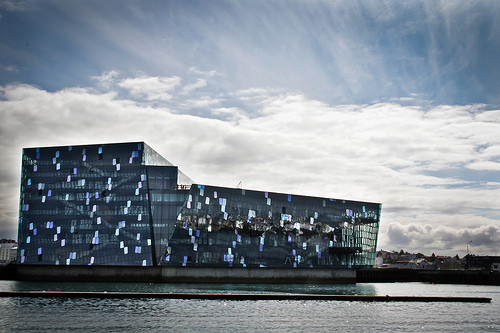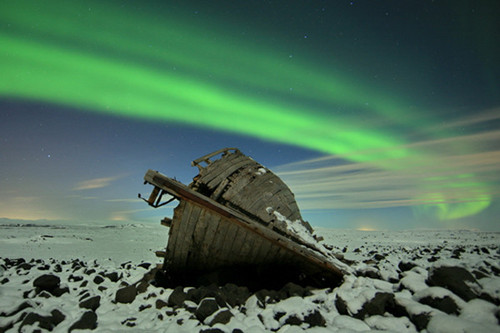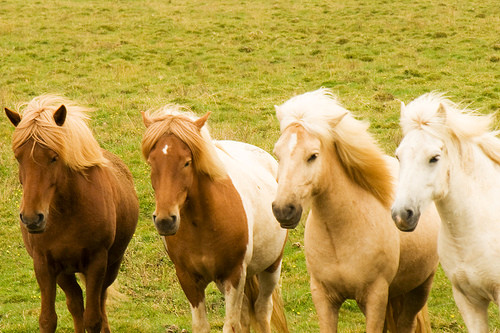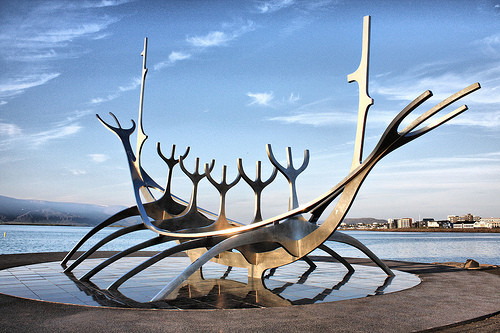Iceland - Why would one want to visit?
The answer is simple, and once one knows, not surprising!

Iceland is a land of tales, legends, volcanoes, hot springs and glaciers. Probably, nowhere else on earth are the forces of nature more evident than here.
Iceland is the closest European country to the United States—four-and-a-half hours from New York to Reykjavík, Iceland’s capital.
Iceland is a European island country in the North Atlantic Ocean on the Mid-Atlantic Ridge. Iceland is a hot spot of volcanic and geothermal activity: 30 post-glacial volcanoes have erupted in the past two centuries.
The population is about 320,000 and the largest city is Reykjavík.
The settlement of Iceland began in AD 874 when the chieftain Ingólfur Arnarson became the first permanent Norse settler on the island. Over the following centuries, Norsemen settled Iceland, bringing with them slaves of Gaelic origin. From 1262 to 1918 Iceland was part of the Norwegian and later the Danish monarchies.

Iceland has an eerie moonscape under a spiritual-like subarctic – the air smells different—clean and crisp—and it’s so clear that on a sunny day you can see for miles, literally!
Iceland is evolution in process: a vast volcanic terrain where forces manipulate the land. Awe striking features of lava, gushing geysers such as Geysir in The Golden Circle; hot springs; fissures and slow, grinding glaciers are so picturesque that at times they seem illusory. You can bathe in turquoise colored lakes, stand behind a toppling cascade of crystal clear water or walk across a dazzling-white icecap.
Visitors come to this often awe-inspiring country to experience Icelandic nature, to enjoy its beauty and to learn.
National Parks demonstrate and awaken respect for the environment. There are now three National Parks around the country, each with its own particular points of interest.
Vatnajökull National Park is the largest national park in Europe. Covering an area of some 12,000 km (11% of Iceland), few other places in the world exhibit the effects of such a wide range of natural phenomena. The battle between ice and fire still rages within the National Park’s boundaries. Thingvellir, “Symbol of the Icelandic Consciousness”, is in a rift valley between the American and European geological plates and Lake Thingvellir contains species of fish found nowhere else. Snæfellsjökull National Park is at the foot of a volcano and glacier, and is steeped in mystery and romance; it is the only Park that reaches from the seashore to the mountaintops.
But this land of boiling mud pools, spurting geysers, glaciers and waterfalls is also an adventure playground. Its breathtaking landscape is an inspiration to artists and photographers.
Iceland’s summers are surprisingly warm, lush and green, with days lengthening until midsummer, when the sun dips down to the horizon but never sets.
During winter you can marvel at the amazing, undulating green, blue, yellow and pink lights of the aurora in the night sky, and the winters are not as cold as you might imagine.
And Iceland’s water life are larger-than-life: there’s no better place on earth to come eye-to-eye with lustrous, spouting whales or puffins that flutter in their millions along the tops of towering sea-cliffs.
And here is something that you would not know...

Icelandic horses will ‘star’ in the upcoming Hobbit Film.
Thirteen Icelandic horses were used in the Peter Jackson film, “The Hobbit,” which is due to be released in December 2012. Cali Madincea of New Line Cinema said, “The look of the Icelandic horse, which grows a thick coat in the winter, was one of the things that attracted the attention of the producers.”
Reykjavík

Reykjavík (Icelandic pronunciation: ['rei:ca,vi:k] (listen)) is the capital and largest city in Iceland and is the world’s northernmost capital city of a sovereign state. It is located in southwestern Iceland, on the southern shore of Faxaflói Bay. With a population of around 120,000 (and over 200,000 in the Greater Reykjavík Area) it is the heart of Iceland’s economic and governmental activity.
Reykjavík is believed to be the location of the first permanent settlement in Iceland, which Ingólfur Arnarson is said to have established around 870.
Reykjavík has been designated as a UNESCO City of Literature. With this nomination, Reykjavík joins Edinburgh, Melbourne, Iowa City and Dublin, as the fifth City of Literature, in the Creative Cities Network. The city can boast of being the first non-native English speaking city to receive this distinctive title.
There is a lot to do in Reykjavík, there are a number of art galleries, theatres and concert venues, and no visit to Reykjavík would be complete without going to at least one of the geothermal pools.
Walking in Reykjavík is highly recommended, as many attractions are within easy walking or bicycling distance from the hotel area. The city is beautiful, and the sidewalk and pathway system is first-rate. Unknown to many visitors: there is a very long and scenic pathway for walking and cycling that circles almost the entire city. A good starting point is anywhere where the city touches the sea. The path leads by an outdoor swimming pool, a sandy beach, a golf course, and a salmon river.
And here’s something else that perhaps you did not know and may surprise you!
You can golf in Iceland. Playing golf in Iceland is an adventure you will, no doubt, relate to your all your tee partners.
Do you think playing golf at midnight surrounded by lava fields’ sounds too strange to be true? Not in Iceland. And you can even play the links at Midnight. Sweeping mountains and majestic ocean views characterize Iceland’s courses, which follow the contours of the naturally dramatic landscape. The golf season in Iceland generally runs from late May to early September.
So, when you are looking for the different, and somewhere that would for certain be memorable, consider don’t let the Ice in Iceland deceive you! It’s a very cool trip!








